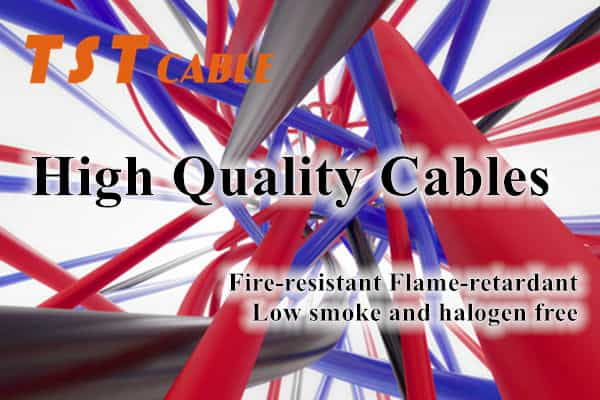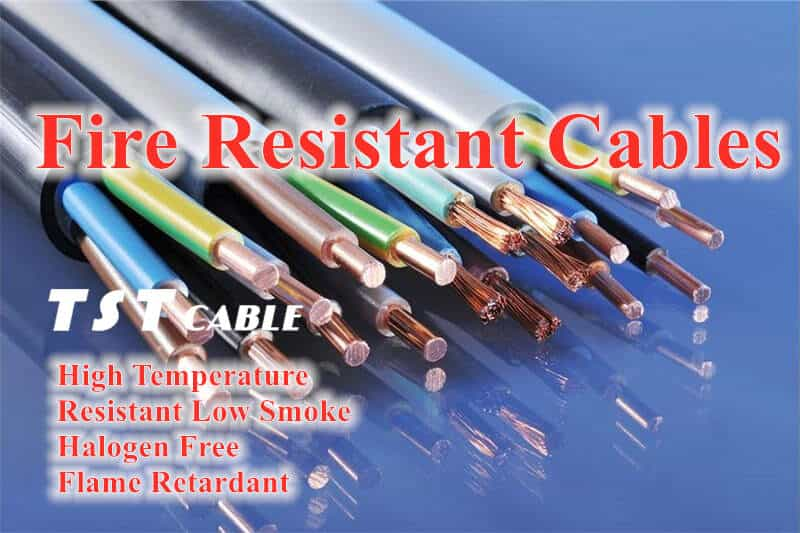
First, control cable is used in industrial and mining enterprises, energy and transportation sectors, etc., for control, protection and signal transmission lines with AC rated voltage 450/750V and below. Copper conductors are applied to control cables.
Main performance:
DC resistance: for example, at 20℃, the resistance of 0.4mm copper wire is less than or equal to 148Ω/km; the resistance of 0.5mm copper wire is less than or equal to 95Ω/km.
Insulation electrical strength: no breakdown at 1kV within 1 minute between conductors; no breakdown at 3kV within 1 minute between conductors and shield.
Insulation resistance: the insulation resistance of the control cable should be greater than 10000MΩ.km.
Second, the rated voltage of the control cable shall not be lower than the operating voltage of the connected circuit should be selected 450/750V.
Third, the choice of insulation type and sheath type of control cable should be in line with the laying environmental conditions and environmental protection requirements, and in line with the relevant provisions.
Fourth, the choice of the number of control cable cores should be consistent with the following provisions:
1) Multi-core cables are applied to control and signal cables. When the core cross-section of 1.5 when mm2 and 2.5 mm2. the number of cable cores shall not exceed 24 cores. When the core cross-section of 4 when mm2 and 6mm2, the number of cable cores shall not exceed 10 cores.
2) control cable should be left with a spare core. Spare core should be considered cable length, core cross-section and cable laying conditions.
3) The same control cable is not used in the following circuits.
- AC current and AC voltage circuits, AC and DC circuits, strong and weak circuits;
- Low level signal and high level signal circuits;
- Control circuits for double-set trip coils of AC circuit breakers and weak power control circuits for each phase of split-phase operation;
- Star wiring and open triangle wiring circuits from the power distribution unit to the relay room.
4) Each pair of round-trip conductors of a weak circuit shall be placed in the same control cable.
5) The three-phase conductors and neutral conductor of the secondary winding of the same current transformer shall be placed in the same control cable.
(6) The same voltage transformer star wiring secondary winding of the three-phase conductor and its neutral conductor should be placed in the same control cable. The same voltage transformer open triangle wiring secondary winding 2 (or 3) conductors should be placed in the same control cable.

V. Control cable cross-section should be selected in accordance with the following provisions:
1) the current circuit section of the protection device should make the current transformer error does not exceed the specified value;
2)The voltage drop of the cable shall not exceed 3% of the rated secondary voltage;
3) The voltage drop of the connecting cable between the power bus and the controlled equipment shall not exceed 10% of the rated secondary voltage;
4) strong control circuit cross-section is not less than 1.5mm2. weak control circuit cross-section is not less than 0.5mm2;
5) measurement circuit cable cross-section should be in line with the current national standards “power device measurement instrumentation device design specifications” GB / T 50063. Control cable implementation standard GB9330-2010. if the flame retardant cable, should also comply with the technical conditions of the IEC337-8 standard.
Fifth, the choice of metal shielding of control cables should comply with the following provisions:
1)Strong voltage power distribution units or with high voltage cables in parallel longer and need to suppress interference outside, 1)Strong power control cables do not contain metal shielding;
2)Control cables for weak electrical signals and control circuits shall have metal shielding in the absence of effective anti-interference measures;
3) Cables for relay protection and secondary circuits of computerized monitoring systems shall be shielded;
4) DC power supply cables for control and protection equipment shall be shielded cables.
VII. The selection of metal shielding type of control cable shall be based on the possible impact of electrical interference to take comprehensive measures to suppress interference, to meet the requirements of reducing interference or overvoltage, and to meet the following provisions:
1) weak control cables located in power distribution installations above 110kV shall use total shielding or double-layer total shielding.
2)The control cables of current, voltage and signal connectors of integrated circuits and microcomputer protection shall be shielded cables.
3) The shielding selection of control cables for signaling circuits of computer monitoring system shall comply with the following provisions.
- total shielding can be used for switching signals;
- high-level analog signals should be selected twisted core of the total shielding, if necessary, can also choose to twist the core of the sub-shield;
- Low-level analog signals or pulse volume signals shall be divided into stranded-core shielding and, if necessary, composite total shielding.
4) In other cases, the appropriate type of shielding should be selected according to the electromagnetic induction, electrostatic induction and ground potential rise and other influencing factors.
5) When the cable has steel armor and metal jacket, it should make full use of its shielding function.
VIII. The grounding method of metal shielding of control cables shall comply with the following provisions:
Metal shielding standards:
For the metal shielding layer of the control cable, the standard mainly involves the material, structure and performance requirements of the shielding layer to ensure that the cable can effectively resist external electromagnetic interference in the course of use, to ensure the stability of signal transmission.
Material requirements: the metal shielding layer should be selected with good conductivity, corrosion resistance of materials, such as copper tape or copper wire.
Structure requirements:
In the copper tape shielding method, the average lap rate of the copper tape should be not less than 15% of the width of the copper tape (nominal value), with a minimum value of not less than 5%.
The thickness of copper tape for single-core cables shall be ≥0.12mm; the average thickness of multi-core cables shall be ≥0.10mm, and the minimum thickness of copper tape shall be not less than 90% of the nominal value.
If copper wire shielding is used, it consists of sparsely wound soft copper wires, the surface of which should be tied by reverse-wound copper wires or copper tape, and the average gap between neighboring copper wires should be no more than 4mm.
Performance requirements: the metal shielding layer should have good conductivity and shielding effectiveness, can effectively block the interference of electromagnetic waves, to protect the stability of signal transmission within the cable.
Nine, what are the models of control cables?
With the letters control cable KVV said, K said control cable, V said polyvinyl chloride, generally used in the energy and transportation sectors to control or protect the line, belonging to the electrical equipment cable series. For the models and types of control cables, Jinhotai cable briefly summarized.
Basic parameters of control cables
- Control cable implementation standard GB9330-88
- Core conductor long-term allowable operating temperature of 70 ℃, cable laying, the ambient temperature of not less than 0 ℃
- The number of cores of the cable can be produced for 3-61 cores
- Cable KVV and KVVR type structure: conductor, insulator, jacket, sheath.
- Control cables are widely used in cities, cable trenches, pipelines and other fixed places.
- Control cables commonly used models KVV, KYJV, KVVP, KVV22, ZC-KVV, N-KVV, WDZ-KYJY and so on.
Control cable model and use
1、ZC-KVV flame retardant control cable is suitable for PVC insulated and PVC sheathed control cable, used in industrial and mining enterprises, energy and transportation sectors, AC rated voltage 450/750 volts below the control, close to and protect the line.
2, NH-KVV fire-resistant control cable has high fire resistance, in a certain period of time directly burning flame will not occur short circuit and short circuit failure. This product is suitable for various occasions of fire hazard and high importance of fire safety, as the connection line between electrical equipment and control system.
3, WDZ-KVV low-smoke halogen-free control cable low smoke emission when heated, halogen-free thermoplastic or thermosetting, suitable for crowded, low air density occasions.
Recommended control cable models (TST CABLES can be customized according to actual needs)
KVV-Copper core PVC insulated PVC sheathed control cable.
KVVP3 – Copper core PVC insulated PVC sheathed aluminum foil shielded control cable.
KVV 22 – Copper core PVC insulated PVC sheathed steel tape armored control cable.
KVVRP – Copper core PVC insulated PVC sheathed braided shielded control flexible cable.
KVVP 2 – Copper core PVC insulated PVC sheathed copper tape shielded control cable.
KVVP-Copper core PVC insulated PVC braided shielded control cable.
KVVR – Copper core PVC insulated PVC sheathed control flexible cable.
Control Cable Manufacturer TST CABLES
TST CABLES control cables, stable transmission, in control! TST CABLES control cables are made of high standard military materials, with excellent moisture-proof, anti-corrosion, anti-damage, anti-radiation, low-smoke, halogen-free, flame-retardant characteristics, to ensure stable and error-free signal transmission. The multi-core design meets the needs of complex circuits, making your industrial automation, energy transportation, aviation, nuclear power, wind power, ships and other projects more reliable and efficient. Strictly enforcing several national standards and passing multiple quality tests, it guarantees the stable operation of your project.
TST CABLES–Specializing in high temperature resistant cable applications and solutions
Fluoroplastic Cables|Polyimide (PI) Cables|Polyetheretherketone (PEEK) Cables|Silicone Rubber Cables
Rail way | Aviation | Marine | Nuclear | Oil & Gas | Wind Power industry applications
For more information on Silicone Cables,low-smoke, halogen-free, flame-retardant, high-temperature-resistant cables or to customize cables for your machinery or system, visit https://www.tstcables.com/product/
or send an e-mail to:lixiangchao@testeck.com
Also available in:
English

